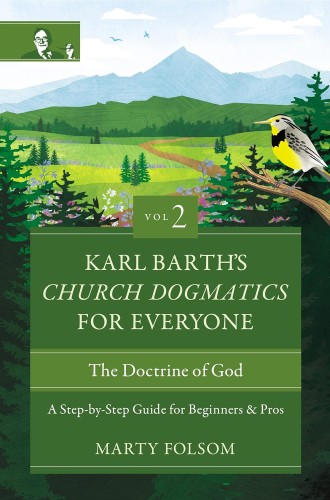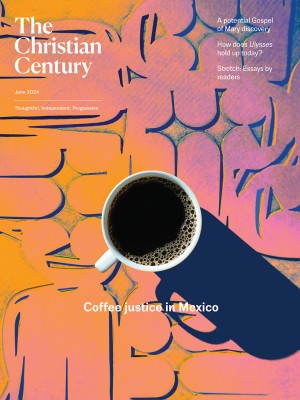Karl Barth in a nutshell
Marty Folsom does what no previous scholar has done: make Church Dogmatics available to all.

Karl Barth’s Church Dogmatics for Everyone
Volume 2, The Doctrine of God
Kornelis Miskotte once said that Karl Barth’s Church Dogmatics was as tough of a read as Moby-Dick. This may be unfair to Moby-Dick. I’ve made repeated attempts to infect seminarians with my love of Barth, and student course evaluations said that I mostly failed.
The fact that Barth has been more admired or criticized than read is mostly his own fault. He doesn’t just do theology; he attempts to rewrite readers into a whole new world where God in Jesus Christ matters more than anything. It takes him 6 million words to do this, and he dies before finishing what he wants to say. Barth reads scripture carefully but creatively, believing it to be the judge and sole source of all we know of God. (Only Barth would highlight Judas, with 90 pages of exegesis, as the prime exemplar of God’s gracious election!) Church Dogmatics defiantly, notoriously resists abridgment or summarization. Every paragraph depends on every other, and the whole ought to be read in order fully to understand any part.
Read our latest issue or browse back issues.
Undaunted by the obstacles presented to readers of Barth, New Zealander Marty Folsom does what no previous scholar has done: make Church Dogmatics available to all. In this volume, the second in his series, Folsom offers a gracious and perceptive invitation into volume 2 of Church Dogmatics, The Doctrine of God. Although Barth despised synopsis or condensation of his work, Folsom boldly presents volume 2’s 1,500 pages in 370, covering paragraphs 25–39, no small feat. (Some of Barth’s “paragraphs” are a couple hundred pages long.)
“This book is all about nutshells,” Folsom says, but it’s far better than a summary of Barth for beginners. It’s an expertly guided tour in which a native guide, who knows and loves every inch of the terrain, shares what astounds him, hoping we’ll be astounded too. Folsom uses the metaphor of music to draw us into the tour, noting that “metaphors open our eyes and ears to see and hear more clearly” and thereby “illuminate Barth’s point.” While Barth was notoriously suspicious of metaphor and analogy, Folsom makes the metaphor work as an invitation into the strange new world of Barth. Light, playful drawings created by Abigail Folsom illuminate the musical theme.
Folsom displays volume 2 of Church Dogmatics as the summit of Barth’s theological ascent and the vantage point from which Barth views and reviews everything in the subsequent volumes. Folsom shows how Barth explosively corrects both Augustine and Calvin as he reworks them into his doctrine of election, which he calls “the sum of the Gospel.” For Barth, Jesus Christ is God’s eternal election to be God for us and for us to be for God, God’s unbounded, active yes to all. As Folsom explains,
Barth does not argue that God chooses some for heaven and some for hell. Instead, he engages God’s eternal decision in Jesus to be for all humanity—whether or not they respond. The doctrine of election is not an eternal decree that binds God’s hands, keeping Him from further involvement with humankind. It is God’s choice to be for and with humanity as the Lord who loves in freedom.
Folsom’s summaries are concise, witty, accessible, and presented in the spirit and tenor of Barth: “When teaching on election elicits fear, God’s part is almost certainly being misrepresented.” Folsom’s discussion of Barth’s brilliant modification of supralapsarianism is without peer in Barth studies, and his deft exposition of Barth’s alleged universalism is just as impressive.
Again, Folsom: “In coming to church, people should expect to meet with the God who speaks. It is best to come with a sense of wonder, but not wondering what is in it for them. The goal is to know the reality of God and to connect deeply with the God who made them and loves them. Hopefully, they will leave as those who didn’t even know what they were missing.” Barth couldn’t have said it better.
Anybody reading Barth must deal with his dated, exclusively masculine pronouns for God. Since the goal of this volume is to make Barth accessible to everybody, I wish Folsom had followed more inclusive contemporary practice.
The volume concludes with short essays by scholars reflecting upon the value of Church Dogmatics, volume 2, for biblical studies, pastors, ordinary people, mental health, spiritual formation, and more. Including these voices was one of Folsom’s best ideas. (Jeremy Begbie’s little essay on volume 2 and the arts ought to be expanded into a book.) Folsom includes the voices of a New Testament professor, a psychiatrist, and a software developer, but no women—which is a commentary on either the limits of Folsom’s circle of friends or the limited range of contemporary readers of Barth. Still, after having plowed through so much Barth, it’s great to end with distinguished readers saying, in their distinctive ways, “Here’s why Barth is worth the work.”





